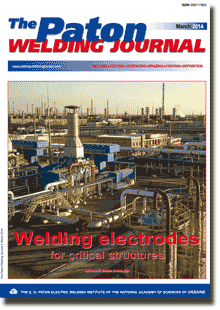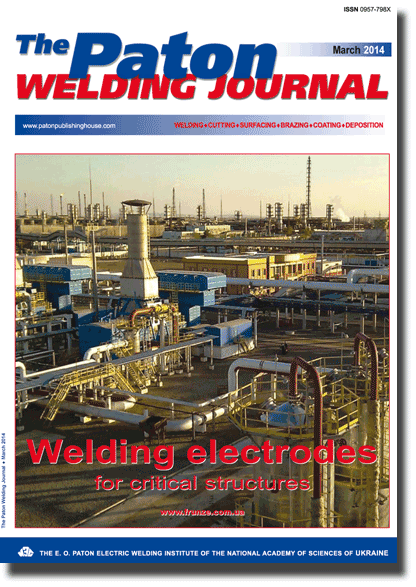| 2014 №03 (04) |
DOI of Article 10.15407/tpwj2014.03.05 |
2014 №03 (06) |

The Paton Welding Journal, 2014, #3, 25-32 pages
DETONATION COATINGS OF COMPOSITE POWDER OF FERROMOLYBDENUM-SILICON CARBIDE PRODUCED USING METHOD OF MECHANICAL-AND-CHEMICAL SYNTHESIS
Yu.S. BORISOV1, A.L. BORISOVA1, E.A. ASTAKHOV2, A.N. BURLACHENKO2, Z.G. IPATOVA2 and V.F. GORBAN2
1E.O. Paton Electric Welding Institute, NASU. 11 Bozhenko Str., 03680, Kiev, Ukraine. E-mail: office@paton.kiev.ua
2I.N. Frantsevich Institute of Problems of Materials Science, NASU. 3 Krzhizhanovsky Str., 03680, Kiev, Ukraine. E-mail:epp@ipms.kiev.ua
Abstract
Investigation of formation of particles of composite powder in the process of mechanical-and-chemical synthesis at processing of mixture of powders of ferromolybdenum and silicon carbide in planetary mill was carried out. It was established that as a result of this process the formation of molybdenum carbide and also silicides of iron and molybdenum with increase of average microhardness of particles from 7270 to 10,520MPa is occurred. The produced powders are used for detonation spraying of coatings. The properties of coatings of powder FeMo and composite powder FeMo-SiC were investigated using methods of metallography, X-ray diffraction phase analysis, microindenting, and their resistance to wear and corrosion was measured. Basing on the results of microindenting it was established that the complex of mechanical characteristics (HIT, E, eel, sel) of detonation coating of composite powder FeMo-SiC exceeds as to its level the same data for the coating of powder FeMo, and values HIT/E* and /E*2, used for evaluation of wear resistance, allow predicting increased resistance to wear for the coating FeMo-SiC as compared to the coating FeMo. The application of map of types of structural states of material, basing on the ratio of values of HIT and eel, allowed evaluating the state of coating of composite powder FeMo-SiC as micronanostructured one. The measurements of wear and corrosion resistance of detonation coating of FeMo-SiC as compared both to FeMo coating and also detonation coating of mixture of powders NiCrBSi-WC (according to wear resistance) and of galvanic chromium (according to corrosion resistance) showed considerable advantage of the first ones. The reasons for such increase of functional properties in detonation coating of composite powder FeMo-SiC should be attributed to the presence of sprayed particles of products of mechanical-and-chemical synthesis, in particular of silicide phases, and high dispersity of formed structure of coatings. 14 Ref., 5 Tables, 10 Figures.
Keywords: detonation spraying, coating, composite powder, mechanical-and-chemical synthesis, ferromolybdenum, silicon carbide, phase composition, microhardness, microindenting, mechanical properties, micronanostrucutred state, wear resistance, electrochemical characteristics
Received: 16.12.14
Published: 28.03.14
References
- Kulik, A.Ya., Borisov, Yu.S., Mnukhin, A.S. et al. (1985) Thermal spraying of composite powders. Leningrad: Mashinostroenie.
- Borisova, A.L., Borisov, Yu.S. (2008) Application of processes of self-propagated high-temperature synthesis in technology of thermal spraying of coatings. Poroshk. Metallurgiya, 1/2, 105-125.
- Borisova, A.L., Borisov, Yu.S., Shvedova, L.K. et al. (1979) Interaction in Cr-SiC system in conditions of conventional and plasma heating. Ibid., 10, 79-84.
- Borisova, A.L., Borisov, Yu.S., Polyanin, B.A. et al. (1985) Interaction in Ti-SiC composite powders and properties of sprayed coatings. Ibid., 10, 92-96.
- Borisov, Yu.S., Borisova, A.L., Adeeva, L.I. et al. (1995) Composite plasma coatings Ti-Si-C. Problemy Spets. Elektrometallurgii, 3, 62-70.
- Borisov, Yu.S., Borisova, A.L., Shvedova, L.K. (1986) Transition metal-nonmetallic refractory compounds composite powders for thermal spraying. In: Proc. of ITSC on Advances in Thermal Spraying (Montreal, Canada, Sept. 8-12, 1986). Pergamon Press, 323-332. https://doi.org/10.1016/b978-0-08-031878-3.50037-x
- Grigorenko, G.M., Borisova, A.L., Borisov, Yu.S. et al. (2002) Investigation of interphase interaction of ferrotitanium with silicon carbide in powder mixtures used for thermal spray coating. Advances in Electrometallurgy, 4, 30-33.
- Grigorenko, G.M., Borisova, A.L., Borisov, Yu.S. et al. (2003) Investigation of interphase interaction of ferrotitanium with boron carbide in powder mixtures for deposition of thermal coatings. Ibid., 1, 26-29.
- Murashov, A.P., Astakhov, E.A., Demianov, I.A. et al. (2003) Wear resistance of thermal coatings produced from composite powders «ferroalloys-B4C, SiC. The Paton Welding J., 7, 43-44.
- Lovshenko, G.F., Lovshenko, F.G., Khina, B.B. (2008) Nanostructural mechanically alloyed materials on the base of metals. Mogilyov: BRU. Firstov, S.A., Gorban, V.F., Pechkovsky, E.P. (2009) New method of treatment and analysis of results of automatic indentation of materials. Kiev: Logos. (1986) Properties, production and application of refractory compounds: Refer. Book. Ed. by T.Ya. Kosolapova. Moscow: Metallurgiya.
- Leyland, A., Matthews, A. (2000) On the significance of the H/E ratio in wear control: A nanocomposite coating approach to optimized tribological behavior. Wear, 246, 1-11. https://doi.org/10.1016/S0043-1648(00)00488-9
- Gorlenko, A.O., Shupikov, I.L., Topolyansky, P.A. et al. (2012) Modification of operating surfaces of parts by deposition of strengthening nanocoating. Metalloobrabotka, 2, 31-36.
Suggested Citation
Yu.S. BORISOV, A.L. BORISOVA, E.A. ASTAKHOV, A.N. BURLACHENKO, Z.G. IPATOVA and V.F. GORBAN (2014) DETONATION COATINGS OF COMPOSITE POWDER OF FERROMOLYBDENUM-SILICON CARBIDE PRODUCED USING METHOD OF MECHANICAL-AND-CHEMICAL SYNTHESIS. The Paton Welding J., 03, 25-32.The cost of subscription/purchase order journals or individual articles
| Journal/Currency | Annual Set | 1 issue printed |
1 issue |
one article |
| TPWJ/USD | 384 $ | 32 $ | 26 $ | 13 $ |
| TPWJ/EUR | 348 € | 29 € | 24 € | 12 € |
| TPWJ/UAH | 7200 UAH | 600 UAH | 600 UAH | 280 UAH |
| AS/UAH | 1800 UAH | 300 UAH | 300 UAH | 150 UAH |
| AS/USD | 192 $ | 32 $ | 26 $ | 13 $ |
| AS/EUR | 180 € | 30 € | 25 € | 12 € |
| SEM/UAH | 1200 UAH | 300 UAH | 300 UAH | 150 UAH |
| SEM/USD | 128 $ | 32 $ | 26 $ | 13 $ |
| SEM/EUR | 120 € | 30 € | 25 € | 12 € |
| TDNK/UAH | 1200 UAH | 300 UAH | 300 UAH | 150 UAH |
| TDNK/USD | 128 $ | 32 $ | 26 $ | 13 $ |
| TDNK/EUR | 120 € | 30 € | 25 € | 15 € |
AS = «Automatic Welding» - 6 issues per year;
TPWJ = «PATON WELDING JOURNAL» - 12 issues per year;
SEM = «Electrometallurgy Today» - 4 issues per year;
TDNK = «Technical Diagnostics and Non-Destructive Testing» - 4 issues per year.


